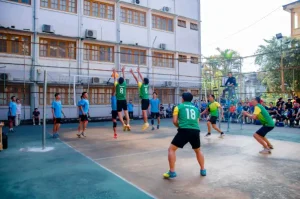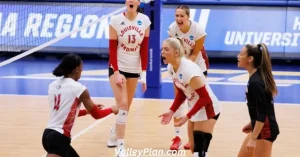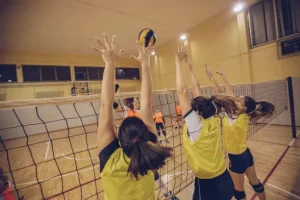Blocking Drills in volleyball is the skill to stop an opponent’s attack by blocking the ball by reaching over the net. This defensive strategy goal is to keep the ball from entering their own half of the court, and it is mostly front-row players, or blockers executing it.
In volleyball, the skill of blocking is necessary which makes you able to change matches. A skillful block can demoralize the opposition and make the pressure on the opposite team.
This guide is helpful for both novice players who are seeking to master the blocking and seasoned players looking to enhance their blocking.
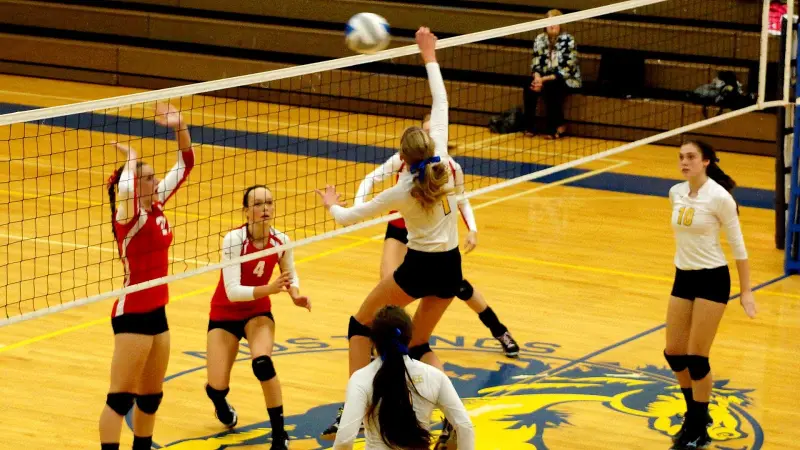
Importance Of Blocking Drills In Volleyball
Effective blocking in volleyball offers several advantages:
| Advantage | Description |
|---|---|
| Defense | It acts as the first line of defense against powerful spikes and tips from the opponent’s attackers. |
| Psychological Impact | A successful block can demoralize the opposing team, affecting their confidence and strategy. |
| Net Presence | A strong blocking presence, consequently, forces the opponent to alter their attack angles and shots, making it more challenging for them to score. |
| Scoring Opportunities | A well-placed block can result in immediate points or transition opportunities for your team. |
| Team Strategy | Blocking is an integral part of the overall team strategy, aligning with the defensive and offensive schemes. |

Fundamentals Of Blocking Drills
Before diving into specific blocking drills, it’s essential to understand the fundamental principles of effective blocking:
1. Footwork And Positioning
- You should begin with your feet shoulder-width apart in an athletic, balanced stance.
- Try to maintain your balance on the balls of your feet so that you can move in any direction.
- Make sure your hands are above the height of the net as you position yourself close to it.
2. Hand Placement
- Hold your hands above the net, forming a strong, wide block.
- Your fingers should be spread, and your thumbs should point downward.
- The goal is to occupy as much space above the net as possible.
3. Eye Focus
- Keep your eyes on the setter’s hands to anticipate the direction of the set.
- Shift your focus to the hitter’s hitting arm and shoulder to predict the attack angle.
4. Timing And Jumping
- Time your jump to reach the peak height at the net when the ball crosses.
- Jump explosively, pushing off both feet simultaneously.
- Your arms should reach their highest point above the net as you block.
5. Penetration
- After reaching the peak of your jump, simultaneously, push your hands and arms over the net into the opponent’s court.
- Aim to penetrate as far as possible without touching the net.
6. Sealing the Net
- Close the gap between you and the net to leave no room for the ball to pass through.
- Work on maintaining a strong, impenetrable block with your fellow blocker.
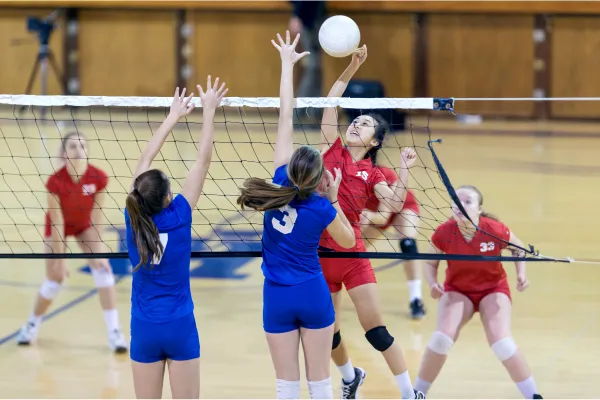
Blocking Drills For Beginners
For beginners, it’s crucial to start with drills that focus on the basic principles of blocking. Additionally, these drills will help you develop proper footwork, hand placement, and timing.
Drill 1: Footwork And Ready Position
Objective: To practice the correct footwork and ready position for blocking.
Instructions:
- Place your feet shoulder-width apart as you stand at the net.
- Try to transfer your weight from one to the other foot to mimic rapid side steps.
- Maintain your equilibrium and be prepared to move in any direction.
- As you pretend to set the ball, have a partner or coach stand on the other side of the net.
Drill 2: Eye Focus And Anticipation
Objective: To improve your ability to read the setter’s hands and the hitter’s intentions.
Instructions:
- Have a coach or teammate stand on the opposite side of the net as the setter.
- The coach or teammate simulates setting the ball to various positions on the net.
- Practice tracking the ball from the setter’s hands to the hitter’s arm and shoulder.
- Work on predicting the direction and angle of the attack.
Drill 3: Timing And Jumping
Objective: To develop the timing and explosiveness of your jump.
Instructions:
- Stand at the net, ready to block.
- Have a coach or teammate toss the ball above the net, just out of reach.
- Practice timing your jump to reach the ball at its highest point.
- Work on a quick, explosive jump to maximize your blocking reach.

Intermediate Blocking Drills
Intermediate players can focus on refining their blocking technique, meanwhile adding more complexity to their training.
Drill 4: Hand Placement And Seal The Net
Objective: To improve hand placement and sealing the net during a block.
Instructions:
- Pair up with a teammate at the net.
- Alternate roles as the middle blocker and the middle hitter.
- The blocker’s objective is to place their hands correctly above the net and seal it effectively.
- The hitter’s goal is to challenge the block with varied attacks. Additionally, this includes line shots and cross-court shots.
Drill 5: Multi-Blocker Practice
Objective: To practice coordinated blocking with multiple blockers.
Instructions:
- Form a group of three or four players at the net.
- Simulate game situations where two or more blockers work together to block an attack.
- Focus on communication and coordination to seal the net and direct the ball to the desired location.
Drill 6: Reading the Setter
Objective: To enhance your ability to read the setter’s intentions.
Instructions:
- Have a setter and a hitter on the opposite side of the net.
- The setter provides various sets, including quick sets, back sets, and high sets.
- As a blocker, focus on reading the setter’s hands to anticipate the type of set.
- Practice adjusting your block based on the set’s location and timing.
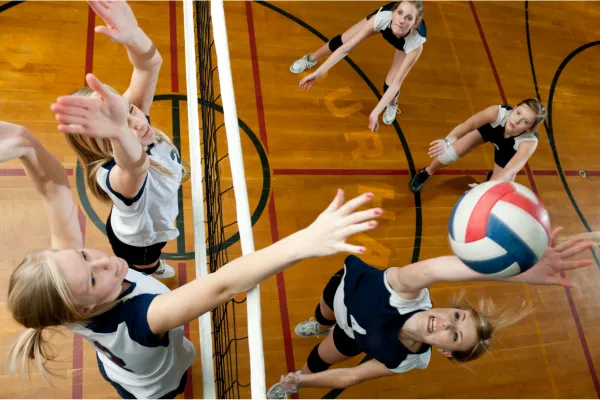
Advanced Blocking Drills
Advanced players can further challenge themselves with these drills that replicate real-game scenarios.
Drill 7: 1-on-1 Blocking Challenges
Objective: To simulate 1-on-1 blocking situations against different attackers.
Instructions:
- Pair up with a teammate and take turns as the blocker and the attacker.
- The attacker attempts a variety of hits, including spikes, tips, and roll shots.
- The blocker’s goal is to effectively block or redirect the attacks while maintaining proper hand placement and timing.
Drill 8: Dynamic Multi-Blocker Practice
Objective: To practice multi-blocker scenarios with dynamic movements.
Instructions:
- Create game-like situations with three or more blockers at the net.
- Incorporate lateral movements and shifts to cover different areas of the court.
- Focus on seamless coordination and communication to form an impenetrable block.
Drill 9: Deception and Mind Games
Objective: To incorporate deception and mind games into your blocking.
Instructions:
- Work with a setter and a hitter on the other side of the net.
- Experiment with delayed blocks, double jumps, and other techniques to confuse the hitter.
- Practice using your positioning and body language to mislead the hitter’s attack direction.

Tips For Improving Your Blocking Drills
Regardless of your skill level, here are some general tips to enhance your blocking drills:
| Tips | Description |
|---|---|
| Stay Aggressive | A passive block is often ineffective. Be aggressive and confident at the net. |
| Video Analysis | Record your blocking drills and matches to review your technique and identify areas for improvement. |
| Consistent Practice | Dedicate time in every practice session to work on your blocking skills. |
| Mental Focus | Stay mentally engaged during drills and matches. Anticipate the opponent’s plays and be ready to react. |
| Learn from Others | Watch professional volleyball matches and observe how elite blockers position themselves and react to attacks. |
| Strength and Conditioning | Incorporate strength training and plyometric exercises to improve your jumping ability. |
| Seek Feedback | Ask coaches, teammates, or experienced players for feedback on your blocking technique. |
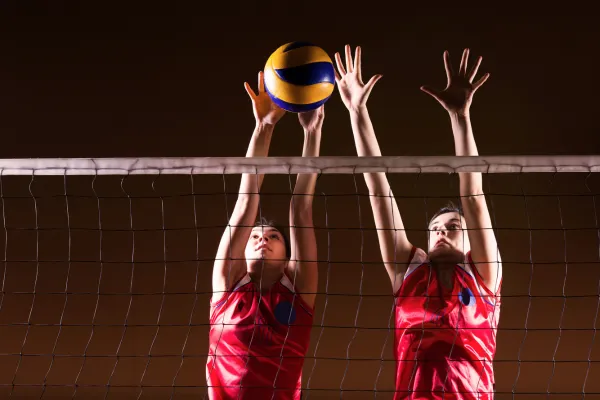
Techniques of Blocking in Volleyball
Blocking is a fundamental skill in volleyball that can greatly impact the outcome of a game. To excel in this aspect of the sport, players must master various techniques that contribute to an effective and strategic block.
Let’s explore some essential techniques of blocking in volleyball.
1. Proper Hand Position
Begin by ensuring your hands are in the right position. Additionally, keep your palms pressed over the net, fingers pointing upward, and hands forming a solid barrier. This foundational technique sets the stage for a strong and impenetrable block.
2. Eye on the Hitter
Maintain a focused gaze on the opposing team’s hitter. This, in turn, helps you anticipate the direction and force of their attack. Furthermore, by carefully reading the hitter’s movements, you can time your block more effectively.
3. Well-Timed Jump
Timing is crucial in blocking. Moreover, execute a well-timed jump as the hitter approaches the ball. This, in turn, requires coordination with your teammates and a keen understanding of the opponent’s offensive strategy.
4. Penetration Across the Net
To maximize the effectiveness of your block, it’s crucial to penetrate the net with your hands and arms. Additionally, extending your reach as far as possible into the opponent’s side of the court is essential.
By doing so, you effectively reduce the attacker’s angles, significantly increasing the chances of a successful block.
5. Closing the Block
Work on closing the block quickly after making contact with the ball. Consequently, this minimizes the chances of the ball sneaking through any gaps in the block. A swift closure also prepares you for the next defensive move.
6. Footwork And Body Position
Pay attention to your footwork and body position. Additionally, position yourself in front of the hitter with your body square to the net. This provides a larger blocking surface and increases the chances of deflecting the ball.
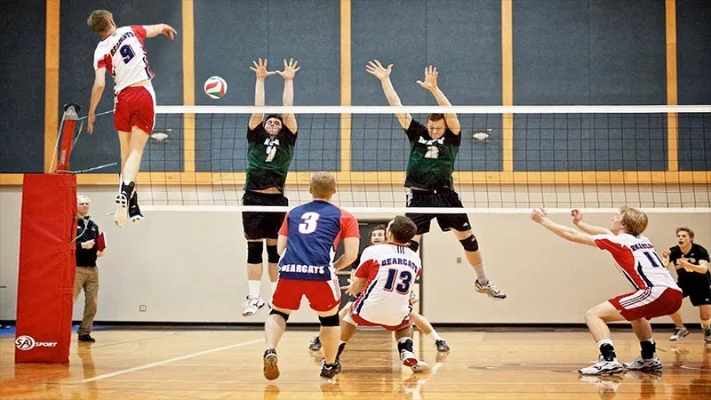
Mistakes To Avoid In Blocking
Blocking can be challenging, and even experienced players make mistakes. However, with careful attention, these errors can be minimized. Here are common mistakes to avoid:
| Mistakes To Avoid | Description |
|---|---|
| Overreaching | Avoid reaching over the net into the opponent’s space, as it’s considered a violation. |
| Leaving Gaps | Ensure there are no gaps between you and your fellow blockers; consequently, a well-formed block should have no holes. |
| Ignoring the Setter | Don’t focus solely on the hitter. Pay attention to the setter’s hands to anticipate the play. |
| Inconsistent Hand Placement | Keep your hands consistently above the net; furthermore, spread wide to cover as much area as possible. |
| Losing Focus | Stay focused on the play and the ball, even after the initial block attempt. |
| Getting Too Predictable | Vary your blocking strategy to keep the opponent guessing. |
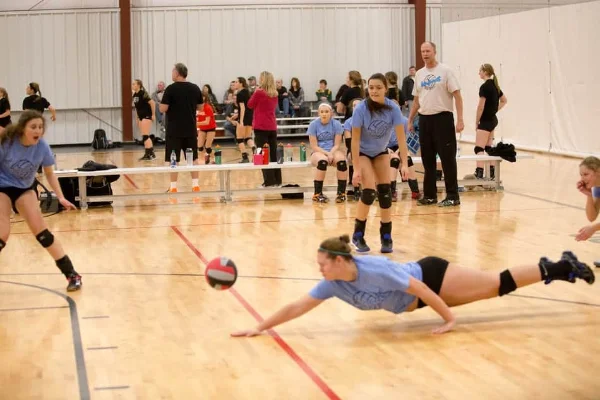
Role Of Blocking In Team Strategy
Blocking is an integral part of your team’s overall defensive and offensive strategy. Here’s how it contributes:
| Role in team strategy | Description |
|---|---|
| Defensive Anchor | Blocking serves as the primary defensive line of protection against attacks. |
| Setting Up Defense | A well-placed block, however, can effectively direct the ball to specific areas on the court, thus making it easier for defenders to dig. |
| Scoring Opportunities | Effective blocking can lead to immediate points or, consequently, transition opportunities for your team’s offense. |
| Psychological Edge | A strong blocking presence can affect the opponent’s confidence and strategic decisions. |
| Game Management | Coaches often utilize blocking strategies to counter specific opponents and, moreover, adapt to changing game situations. |
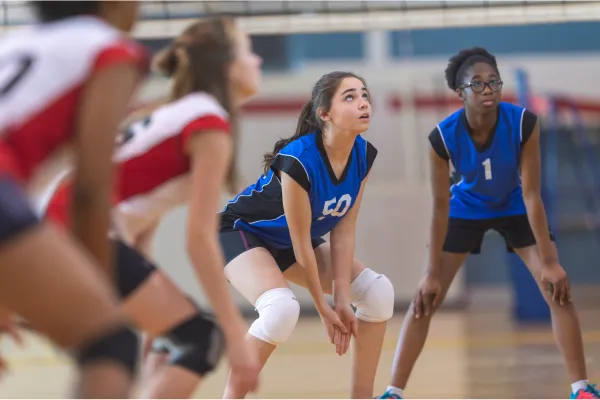
FAQs
Blockers should be ready to block with arms up, elbows out in front, and palms facing the net at eye level. The ball may come over abruptly, so players must be ready to jump and block.
What is volleyball dig? Digs prevent the ball from hitting the floor when an offensive attack, generally a spike, is sent to your side of the court. Digging is for everyone, so keep reading to improve your techniques.
Blocking, which is essential for actors, provides guidance on where to stand and how to move within a scene. Moreover, it serves as an effective tool to convey the plot and subtext, contributing to a more compelling performance.
Incorrect positioning by the player can result in errors. Specifically, if the player touches the net while blocking, it is considered an error. Additionally, if the player’s foot crosses the center line during jumping or landing, it is also deemed an error. Moreover, when players in the back row block the ball, it constitutes a blocking fault.
In volleyball, the middle blocker, also referred to as the middle hitter, holds a crucial position as the tallest player on the team. Additionally, their primary responsibility is to serve as the first line of defense against the hits from the opposing team.
Conclusion
The journey of mastering volleyball blocking requires consistent practice and dedication. To begin, firstly, start with the fundamental principles. Next, progress through appropriate workouts, and always seek opportunities for improvement.
Additionally, consider incorporating varied exercises to enhance your fitness routine. Moreover, blocking drills serve as a dynamic classroom for reading the game.
As players simulate diverse attack scenarios, they enhance their ability to analyze opponents’ movements and predict ball trajectories. This heightened situational awareness becomes a valuable asset during the heat of a volleyball match.
Also remember that blocking is not only about skills but it also includes focus and strategic thinking. As you improve your skills and develop your blocking prowess, you become an asset for your team.
Keep yourself motivated, learn from the experienced players and coaches, and most important, enjoy the process of becoming a best blocker on the volleyball court.
Related Posts
Passing Or Bump Drills in volleyball
Volleyball Conditioning drills
What is Dead Fish Drill In Volleyball
Volleyball Serve Receive Drills

Hassan Baig a former volleyball player, coach and Administrative At Volleyplan.com.
My name is Hassan Baig and I am a former volleyball player and coach. I have a passion for the sport and have dedicated my life to promoting it. I have worked with some of the best players in the game and have helped them achieve their full potential Read More


